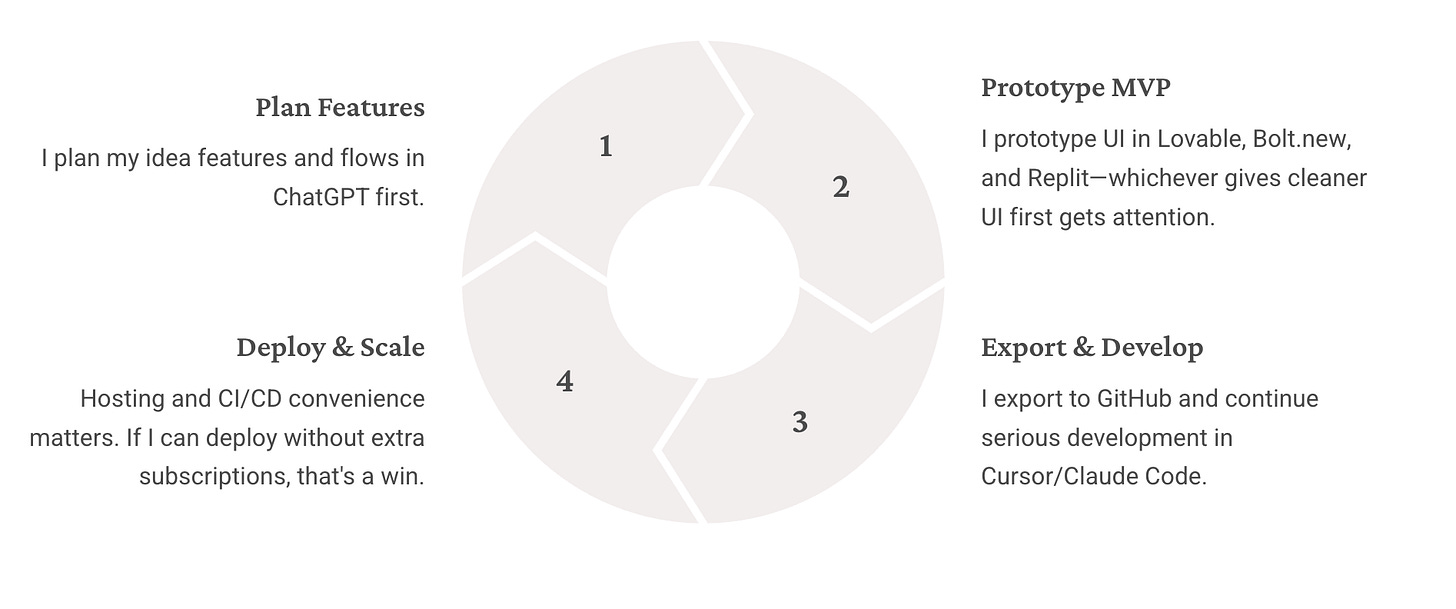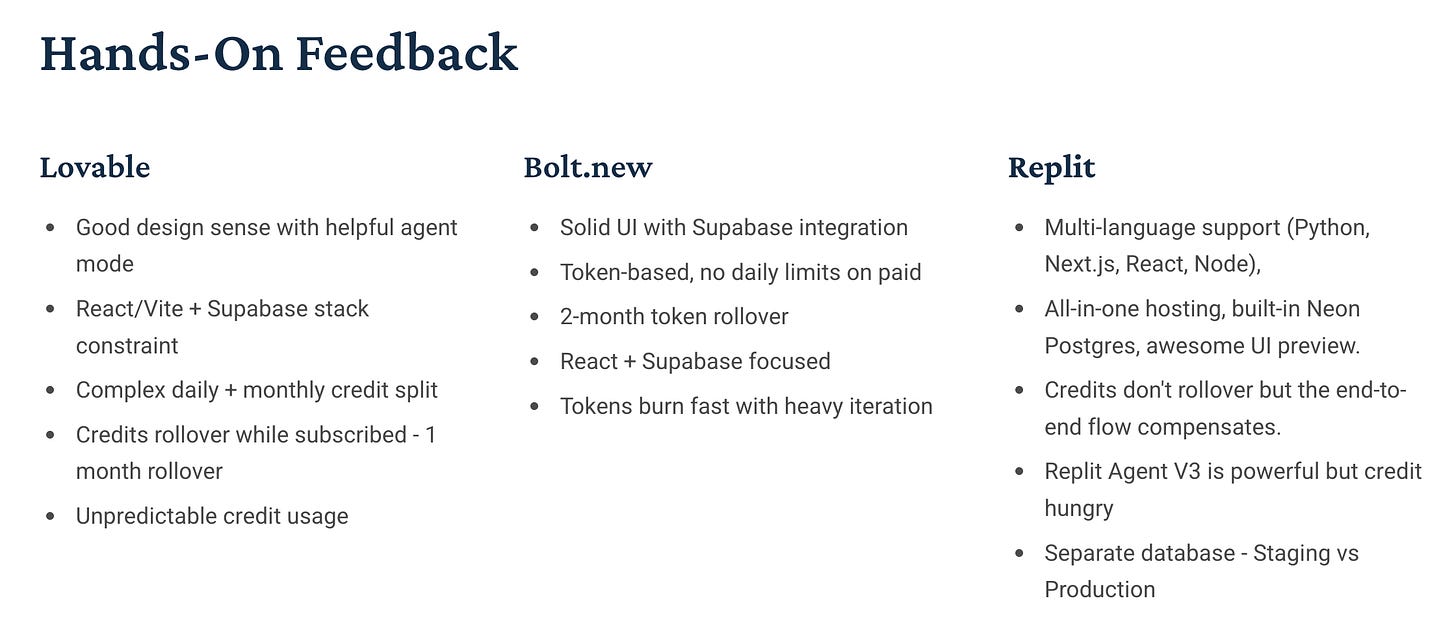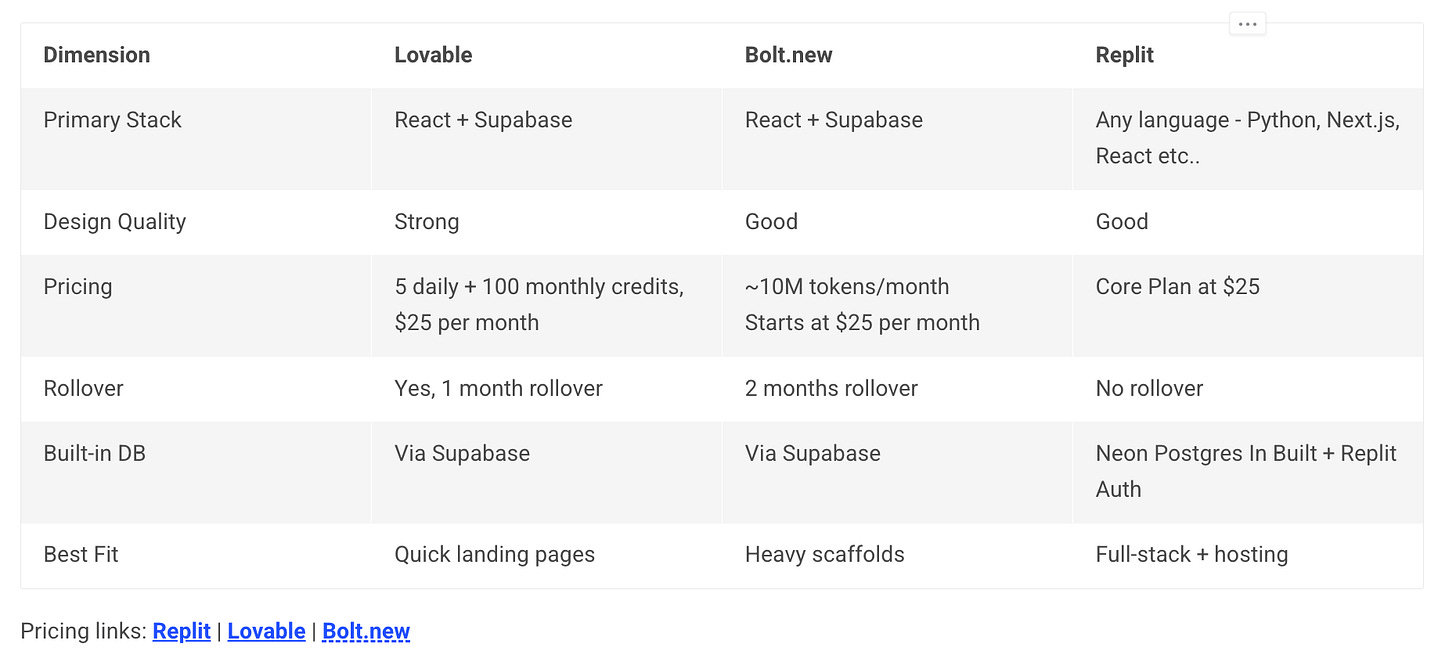Replit vs Bolt vs Lovable (2025) — Hands‑On Review: What I’d Renew, What I’d Pause
Replit vs Bolt vs Lovable (2025): hands‑on comparison of pricing, credits/tokens rollover, stacks, pros/cons, and when to renew
If you’re deciding whether to subscribe—or renew—to Replit, Bolt.new, or Lovable, this is the practical comparison I wish I had when I started. I’ve paid for all three, used them across multiple MVPs, and my decision now comes down to simple questions: and this hands-on review focuses on pricing, credits/tokens rollover, stacks, and renewal decisions for AI app builders and cloud IDEs.
Which one do I actually use frequently?
Am I actually using them everyday ?
Which one saves me time end-to-end? And
Does the pricing/credit model help or get in the way?
I’m not crowning a universal “best.” I’m sharing how I use them, when they shine, and where the pricing or credit limits make me pause.
At first, I was eager to jump in and try every tool. But after a few months, I found myself wondering: am I really using these enough to keep paying for them? How many times do I actually log in and get value?
That’s what I set out to explore here.
Note: I was lucky to get access to all these tools via the Lennys Newsletter, if you need access to all these wonderful tools - check out Lennys Newsletter
No Time to Read? Here’s the Scoop
Use Lovable on-demand for fast, good-looking React + Supabase MVPs (great as an AI app builder for React + Supabase workflows). Pricing splits daily + monthly credits; rollover exists while subscribed but you can rollover only for one month, and custom domains require paid plan.
Go with Replit if you want one place to build in Python/Node/Next.js/React, deploy, and scale with a built-in Postgres (Neon) and CI/CD. No credit rollover, but the end-to-end flow is worth it in my setup. Replit Agent V3 is very powerful and you should try it out.
Use Bolt.new during build sprints: Token-based, no daily limits in paid plan unlike Lovable, and 2-month rollover from July 1, 2025 make budgeting cleaner. Still, heavy iteration can burn tokens fast.
Stack reality: Lovable/Bolt.new are great for React + Supabase scaffolds. For Python/Node backends inside the platform go for Replit.
My approach: I would keep Replit subscription active for now; I would only pay for Lovable/Bolt.new in specific months when I need them.
How I Build Applications
My workflow is straightforward:
I plan my idea features and flows in ChatGPT.
I prototype UI and a MVP in Lovable, Bolt.new, and Replit—whichever gives me a cleaner UI first gets my attention. To be honest, you can do decent amount of this work in their Free Plan as well, if spread across a couple of days.
I export to GitHub and continue serious development in editors like Cursor/Claude Code.
Hosting and CI/CD convenience matters a lot. If I can deploy and scale without juggling extra subscriptions, that pushes a tool up my list.
After using these tools for six months, here’s what I concluded: I would keep Replit running all the time, but only pay for Lovable and Bolt.new when I need them. I might subscribe to them for a month when I’m working intensively, then cancel when I’m done.
Hands-On Feedback - Lovable vs Bolt.new vs Replit
Lovable
Design & agent: Good design sense; the agent mode is helpful for quick landing pages and apps.
Stack constraint: Mostly React/Vite with Supabase backends. Works well for simple full-stack projects, but you can’t build Python or Node backends directly in it.
Pricing & credits: Free plan gives 5 daily credits and 100 monthly on Pro; rollover is supported while you stay subscribed only for one month rollover. Custom domains require a paid plan.
What I don’t like is the split between daily and monthly credits; it feels needlessly complex.
Credit usage : It’s hard to predict how many credits the AI will use. You often end up using more than you expected.
Bolt (StackBlitz) / bolt.new
UI & integrations: Solid UI outcomes; integrates with Supabase, GitHub, etc., similar to Lovable.
Pricing model: Token-based; plans start at ~10M tokens/month with no daily token limit on paid plans. As of July 1, 2025, unused tokens roll over for two months if you keep a paid subscription. This makes budgeting saner than “use it or lose it.”
Stack constraint: Again, geared to React + Supabase. Good for quick full-stack scaffolds, but not for building a native Python/Node backend inside the product.
Reality check: You can use up tokens quickly when you make lots of changes or redo your work often. The rollover feature helps, but you still need to keep an eye on how much you’re using.
Replit
Works with many programming languages: I can use Python, Next.js, React, Node - You are not limited to just one option.
All-in-one hosting: You can publish and deploy your projects directly on the platform. Core plan gives you monthly credits upto $25 per month. Credits restart each month and don’t carry over if unused. (Replit)
Database options: Replit uses Neon Postgres databases. You can easily set up separate development and production databases, which helps keep testing and live versions organized.
Login and website features: Includes Replit’s own login system, custom domain names, and automatic scaling for websites. (Replit)
Awesome UI preview feature: I can see how my user interface looks before finishing the build, saving me from wasting time on designs that don’t work.
Cost concerns: Their latest feature of Replit Agent V3 is very powerful, but using the AI can sometimes unexpectedly use up a lot of credits. Since unused credits don’t roll over, you start over each month.
Tabular Comparison (What actually matters in practice)
Here are the page links for the above platforms:
My Renewal Logic (Plain and simple)
Replit — Renew / Keep active. It’s my go-to platform that’s always available: it works with many programming languages, includes hosting, automatic updates, and database storage. I can create anything from Python programs to web apps without needing to connect multiple different tools. The main drawback is that unused credits don’t carry over to the next month, but I still prefer having everything in one place.
Lovable — Subscribe when needed. I like the design sense and quick agent-assisted landing pages, but the daily + monthly credit split and unpredictable burn keep me from staying subscribed continuously. The good news: credits roll over while you stay subscribed but only a month carry forward.
Bolt.new — Subscribe when needed. Easier to budget with their unlimited daily usage of the tokens thats available to use and two-month rollover on unused tokens. I will pay for it when I’m actively building something
Migration & Lock-In (What to know before you commit)
Lovable/Bolt.new: You’ll likely pair with Supabase. At scale, that’s a second subscription to manage.
Replit: Using the built-in Neon Postgres is convenient. If you ever need to move, Neon is a standard Postgres service—you can migrate to a standalone Neon account later (it’s extra effort, but possible). (Neon)
Other Tools Worth a Look (brief mentions)
v0.dev — I didn’t evaluate it deeply here; keep it on your radar for AI-assisted UI.
Emergent.sh — I built and wrote about a Vedic Math app with it; agentic full-stack flow in one place. (thetoolnerd.com)
Base44, Rocket New — On my watchlist.
Orchids.app — Repeatedly failed me when I tried; I’m not recommending it based on my runs.
Related reading on The Tool Nerd
Summary of my experience
I walked through exactly how I use all three, what I like, and what blocks me. The decision framework is simple:







